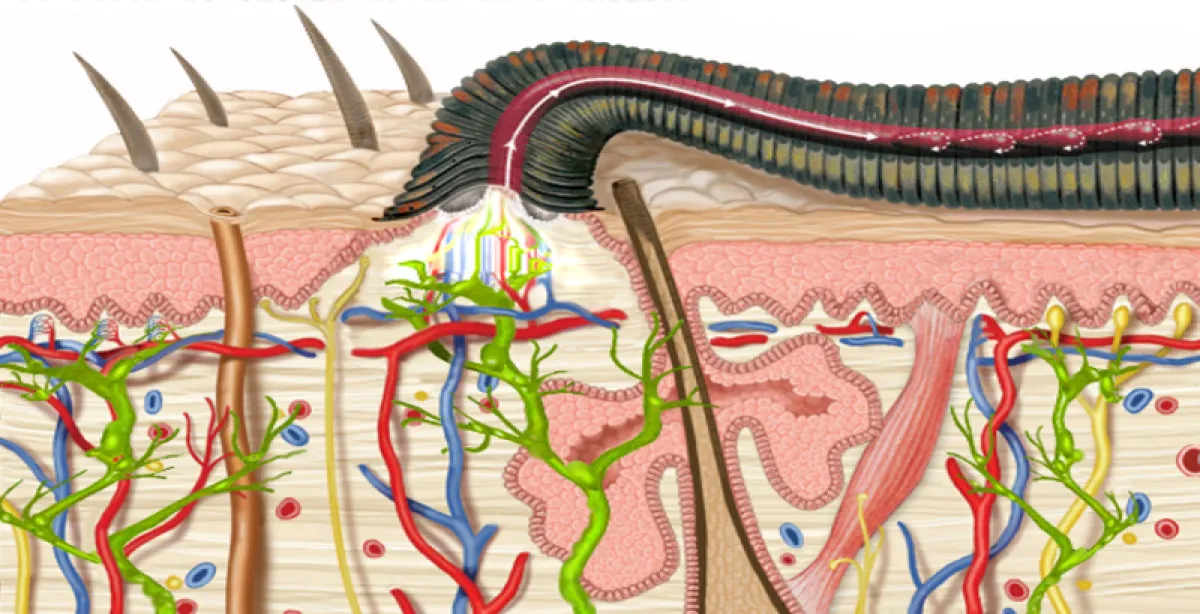Leeches in modern medicine

Many species within the animal and plant kingdom are under protection for various reasons. One of these reasons is that these organisms may have something to offer society that we just haven’t discovered yet. Nature has been perfecting systems far longer than humans have been in the picture, why not explore the ones that already exist? A well-known example of using a natural compound is Taxol, derived from the yew tree, which is readily and successfully used in cancer treatment (Slichenmeyer and Hoff, 1991).
While parasites are generally encountered with fear and disgust, we can learn a lot from them. Leeches and parasitic worms are two perfect examples of this ‘beneficial medicinal use’ in the context of parasites. Leeches are used as ‘the tool’ (the leech itself) as well as the ‘treatment’ (leech saliva) in surgical procedures (Whitaker et al., 2005) and helminths (like tapeworms, pinworms and hookworms) allegedly alleviate some autoimmune (e.g. allergies) (Harnett and Harnett, 2010) and inflammatory diseases (e.g. obesity) (Bhargava et al., 2012).
Thus, treatments can be found in the most obscure places and in the strangest creatures. This is why it is key to keep an open mind when learning about things that you might find off-putting at face value.
Leeches in Modern Medicine
Leeches - wormy looking creatures that crawl up your legs when you’re not looking and suck your blood. Usually followed by a scream and then quickly removed and flung with panic onto the ground. Since taking the ANU undergraduate course ‘Appreciating Parasites’, I have developed a new-found appreciation for our lurking friend, the leech. I’m not going to lie, I now think they are quite cute, and I’m not sure how this happened. Leeches are part of the Annelida family (segmented worms), they feed on blood, and there are almost 700 species worldwide! However, what I have found most fascinating about leeches is their use in medicine. There is a long history of leeches in medicine: leeches the medieval healer. Yet beyond the belief that leeches could cleanse your soul of an evil spirit, leeches are used for a variety of treatments today. The two-main leech species used in medicine are Hirudo medicinalis, and Hirudo verbana.
In my recent encounter with leeches in the above mentioned undergraduate course, one of the most interesting uses for leeches to me was their use in micro-surgery where they are invaluable for salvaging venously congested tissues, often facial. There have even been recorded cases of leeches helping with the re-attachment of severed fingers and ears. Data suggest that without leeches the success rate of successfully re-attaching fingers is under 20%. However, adding these parasitic ‘micro-surgeons’ into the equation, the success rate jumps to more than 50%. The success of leeches in micro-surgery is due to their saliva which aids in preventing clotting as the parasites take up their blood meal. Their saliva contains specific thrombin inhibitors (hirudin), inhibiting the formation of both free and clot bound thrombin. This was first isolated from Hirudo medicinalis, but closely related proteins have been found in other species (Babenko et al., 2020). Leeches can also be used for the treatment of degenerative diseases, such as arthritis by increasing blood flow to the joints (Sig et al., 2017).
At the same time as being fascinated by these wonderful properties and success stories, I also wondered about the issues surrounding foreign saliva and potentially other fluids from the leeches being injected into the patient’s blood stream. Infection post leech application has been reported, even from leeches that have been kept under aseptic conditions. To limit the risk of infection, one of the most effective precautionary methods is to take a course of prophylactic fluoroquinolones, since bacteria associated with leeches are resistant to penicillin-based antibiotics such as amoxicillin and clavulanic acid (Maetz et al., 2012).
Overall, studying parasites has really shed a different light on how I view parasites. While we often only think of them as disease carriers and placing an immense economic burden on society, leeches and some of their parasite ‘mates’ have a proven positive impact on our wellbeing.
- Margot Schneider (ANU Undergraduate student) in collaboration with Dr. Melanie Rug
References

Bhargava, P., Li, C., Stanya, K.J., Jacobi, D., Dai, L., Liu, S., Gangl, M.R., Harn, D.A., Lee, C.-H. (2012) Immunomodulatory glycan LNFPIII alleviates hepatosteatosis and insulin resistance through direct and indirect control of metabolic pathways. Nature Medicine, 18 (11): 1665 DOI: 10.1038/nm.2962
Babenko, V. V., Podgorny, O. V., Manuvera, V. A., Kasianov, A. S., Manolov, A. I., Grafskaia, E. N., Shirokov, D. A., Kurdyumov, A. S., Vinogradov, D. V., Nikitina, A. S., Kovalchuk, S. I., Anikanov, N. A., Butenko, I. O., Pobeguts, O. V., Matyushkina, D. S., Rakitina, D. V., Kostryukova, E. S., Zgoda, V. G., Baskova, I. P., Trukhan, V. M., … Lazarev, V. N. (2020) Draft genome sequences of Hirudo medicinalis and salivary transcriptome of three closely related medicinal leeches. BMC genomics, 21(1), 331. https://doi.org/10.1186/s12864-020-6748-0

Bager, P., Arnved, J., Rønborg, S., Wohlfahrt, J., Poulsen, L.K., Westergaard, T. (2010) Trichuris suis ova therapy for allergic rhinitis: a randomized, double-blind, placebo-controlled clinical trial J. Allergy Clin. Immunol., 125 , pp. 123-130
Harnett, W., Harnett, M.M. (2010) Helminth-derived immunomodulators: can understanding the worm produce the pill? Nat. Rev. Immunol., 10 , pp. 278-284
Maetz, B., Abbou, R., Andreoletti, J. B., & Bruant-Rodier, C. (2012) Infections following the application of leeches: two case reports and review of the literature. Journal of medical case reports, 6, 364. https://doi.org/10.1186/1752-1947-6-364
Sig A.K., Guney M., Uskudar Guclu A., Ozmen E. (2017) Medicinal leech therapy-an overall perspective. Integr Med Res.; 6 (4):337-343. doi:10.1016/j.imr.2017.08.001
Slichenmyer W.J., Von Hoff D.D. (1991)Taxol: a new and effective anti-cancer drug. Anti-cancer Drugs. Dec; 2 (6):519-530.
Whitaker, I. S., Cheung, C. K., Chahal, C. A. A., Karoo, R. O. S., Gulati, A. and Foo, I. T. H. (2005) By what mechanism do leeches help to salvage ischaemic tissues? A review, British Journal of Oral and Maxillofacial Surgery, 43(2): 155-160. Available at: https://doi.org/10.1016/j.bjoms.2004.09.012
